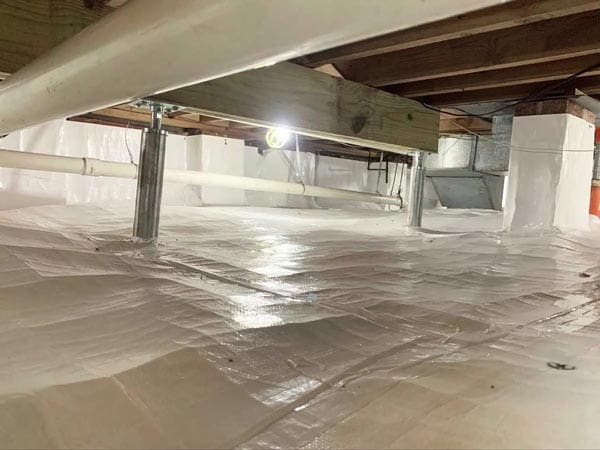Are you noticing an unsettling dip in your floors? Does it feel like you’re constantly walking on uneven ground in your home? If so, you may be experiencing the frustrating and common issue of sagging floors. As a homeowner, one of the last things you want to deal with is a structural problem within your house. However, sagging floors can happen for various reasons, and ignoring them can lead to more serious issues.This blog post will dive into why these pesky problems occur and provide solutions for fixing them. Understanding the root causes and implementing effective repair methods ensures that your home remains safe and sound.
Main Causes of Sagging Floors
There are several reasons why a floor in your home may begin to sag, and each one will require a unique repair solution. Step one is to learn the leading causes, which the three sections below will explain.
Construction Errors

The first cause of sagging floors that we’ll discuss is the construction crew’s errors while constructing your floor. There are several ways that the floor construction process can go wrong, including the following:
If you have a crawl space foundation, floors in your home rely on a set of timber joists and beams for support. The joists run parallel to one another and rest on top of a set of beams that run perpendicular to the joists. Sometimes, the construction crew that builds your floor may fail to add enough joists or make a mistake in how they space them. In either case, the joists will eventually fail to support the weight of the floor, which can lead to significant sagging.
Differential Foundation Settlement
Another cause of sagging floors is differential foundation settlement. Your foundation depends on the soil below it for support. If that soil shifts or sinks, your foundation and the rest of your home will move.
It’s worth noting that a small amount of uniform foundation settlement is typical following construction. However, differential foundation settlement involves uneven shifts that can result in severe structural damage.
When differential settlement occurs, there may be several signs throughout your home. Those warning signs are foundation cracks, jammed windows, and uneven or sagging floors.
Structural Decline and Moisture

Even if those who constructed your crawl space foundation built your floor correctly, the joists and beams can still decay over time. As the structural integrity of the floor support declines, the floor will begin to slope or sag.
Floor supports can receive damage from general wear and tear and direct impacts. However, moisture can also be a significant factor in the longevity of structural components primarily consisting of timber.
Excessive moisture is prevalent in basements and crawl spaces, and it can lead to wood rot if you don’t manage it. As rot worsens, your joists and beams will weaken, which leads to sagging and sloping floors.
For more information, see Sagging Floors Repairs and Causes.
How to Resolve Sagging Floors
Now that you understand some causes of sagging floors, it is time to learn about some of the best fixes for this problem. However, before we share those resolutions with you, it is crucial to note that repairing a sagging floor is not something you should do on your own.
Instead, it is always best to seek the help of a professional repair team. Fixing a sagging floor is both challenging and potentially dangerous if you don’t have experience. Hiring a pro is the best way to do the job safely and correctly. The two sections below explain some common solutions a professional team may offer.
Foundation Underpinning
If your sagging floor results from differential settlement, your repair team may suggest solving the issue via a service called underpinning. Underpinning involves inserting foundation piers into the earth and connecting them to your foundation to add support. Push and helical piers are the most widespread pier types for this job.

A foundation repair team installs push piers using a hydraulic pump to press them into the earth until they hit bedrock or firm strata. The top of the piers attach to your foundation via a bracket. Once the connection is in place, the foundation team can use the piers to raise the foundation as much as possible without causing damage.
Helical piers are pretty similar, but they have one main difference. Rather than requiring a hydraulic pump, helical piers are like giant screws that twist into the earth. The twisting motion embeds the piers in the ground to provide much-needed support to your home.
Structural Reinforcement
Structural reinforcement is likely the best solution if your floor sags due to a problem with the wooden support structures in the crawl space.This repair approach can take many forms based on the structural deficiencies present in your flooring.

For example, if the original builder of your home fails to add enough joists, a simple solution is to install more joists or to attach cross-bridging between the joists. Both of these options add stability to your floor, which will eliminate and help prevent future sagging.
It is also essential to address any moisture problems that may have caused your joists or beams to rot. There are many ways to do this, including installing better drainage systems or setting up a dehumidification system in your basement or crawl space. Regardless of the option your repair team suggests, it’s vital to reduce moisture to make it less likely your floor will sag again.
Hire a Pro to Fix Your Sagging Floors
As we mentioned in this article, you mustn’t attempt a DIY approach to fixing a sagging floor. Instead, leave this work to an experienced foundation repair contractor.
If your sagging floor is due to a foundation or crawl space problem, HydroHelp911 is here to support you and provide the repair service you need. We serve customers in Charlotte, North Carolina, and the surrounding areas. Reach out today to learn more about what we have to offer.




